
A TALE OF TWO CAPTAINS
An Interview with Mark Gruenwald on Captain America
by Peter Sanderson
This article was originally published in AMAZING HEROES Vol. 1, No. 146, August, 1988
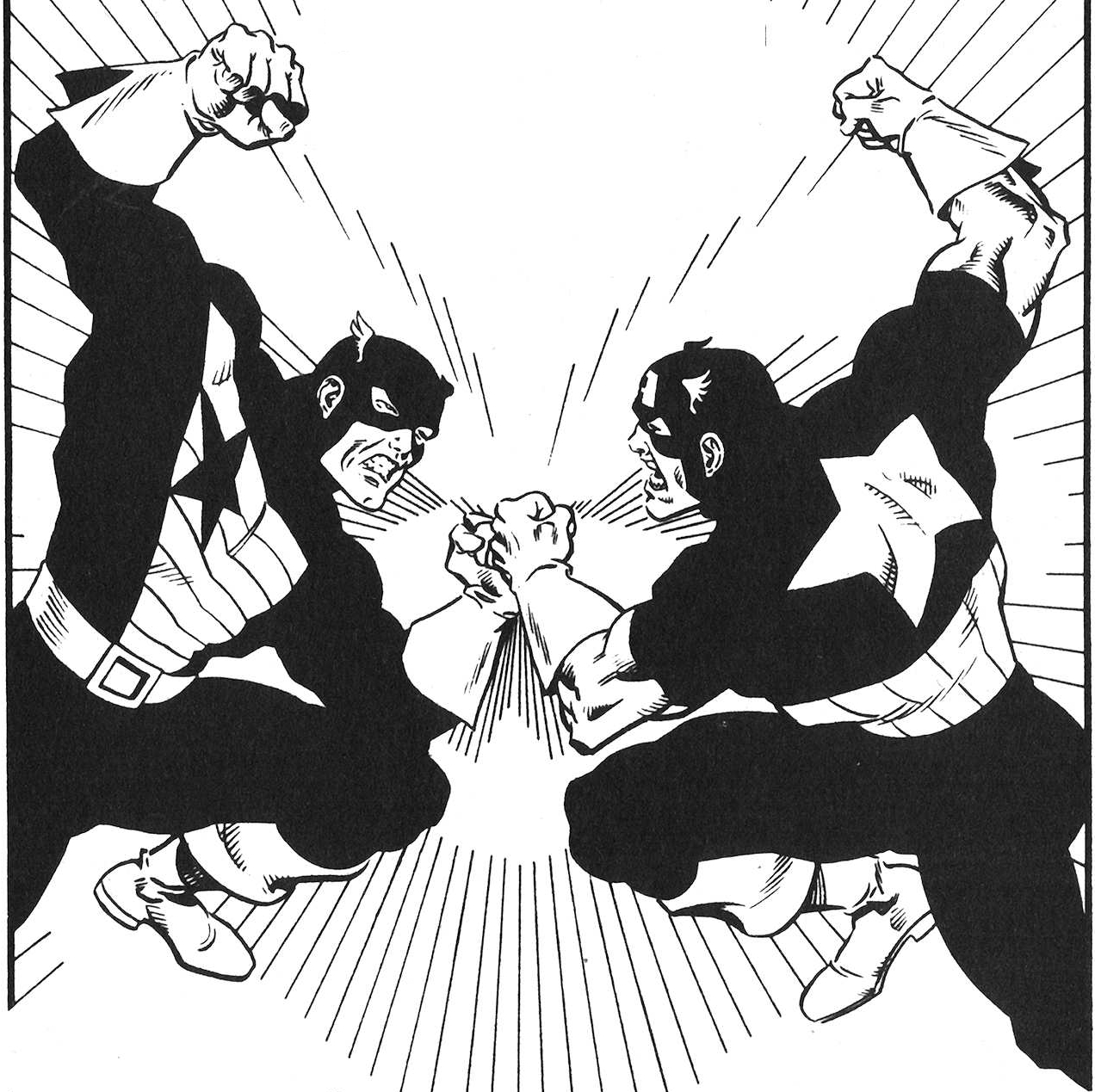
Over the last year and a half, Captain America has experienced a resurgence of popularity, to a large extent due to a controversial turn of events in the series. In effect, the man we knew as Captain America for nearly fifty years is Captain America no longer, someone else is.
Back in 1941, Steve Rogers was given the identity, costume, and shield of Captain America by the federal government. For the most part, Captain America took his orders from the government during World War II. However, after being revived from suspended animation in 1964 and through recent times, he has acted for the most part on his own will [except for those times when he was a member of S.H.I.E.L.D. and the Avengers and that usually wasn’t in his own book, so we’re not counting it].
In the current storyline, the federal government, through its Commission on Superhuman Activities, demanded that Rogers work as Captain America directly for them. Rogers, having come to value his autonomy, gave up the role of Captain America, and the government appointed a rival, John Walker, alias the Super-Patriot, as the new Captain America. For many months now, Captain America has chronicled the adventures of not one but two protagonists: Steve Rogers, the original Captain America, now in a new costumed identity, calling himself simply The Captain, and the new Captain America, a man with a very different approach to his work of fighting injustice.
This storyline is the work of writer Mark Gruenwald, and in the following interview, he explains his reasons behind the surprising events that have taken place in the series lately.
AH: Why are you interested in writing Captain America for the rest of your professional life, which I calculate will mean at least three hundred and sixty more issues?
GRUENWALD: Gee, what issue will I be up to? Issue 700 and something [laughs]. I think Captain America is one of the best comic book concepts ever invented. It has been said there are no bad ideas, no bad characters; it’s all in the execution. I totally disagree with that. I believe that there are good characters and there are bad characters, and furthermore, there are good characters and there are perfect characters — perfect archetypal characters. There are so very few of them in comics. Characters whose conceptual underpinnings just can’t be better, so everything about them works. Superman and Batman are characters that really work. Our best one, as far as an all-around character that really works, is Captain America. I love Captain America because of his thematic basis. He’s an embodiment of American ideals.
AH: What’s going to be happening in Captain America as you approach and reach the three hundred and fiftieth issue?
GRUENWALD: First, there’s a return engagement with Right-Winger and Left-Winger, who premiered [in those particular costumed identities] in Captain America #340. They are former Bold Urban Commandos — Buckies. There were three of them; one of them became Bucky and then later Battle Star (the partner of the Captain America, John Walker). These two guys revealed Walker’s secret identity on national television in #340, which resulted in the deaths of Walker’s parents in #345. #347, which is called “Vengeance,” has the new Captain America tracking down these guys whom he holds responsible for his parents' death.
#348 and #349 feature the return of the Flag-Smasher, who’s not been seen since Captain America #322. It’s Flag-Smasher with a slight difference; he has turned against his ULTIMATUM terrorist organization. He took it over and renamed it, but the organization existed before he got there, and he has just learned that the organization has been, and is funded by, a certain National Socialist. Since Flag-Smasher is anti-nationalistic and anti-patriotic, this shocked him. Flag-Smasher is, in his own way, as big an idealist as Captain America, but his ideals are a lot different from Captain America’s. So, when he found out that someone whom he considers evil, that is, someone who believes in nationalism, is funding his organization, he tried to put a stop to it, and that turned the organization against him. They are just on the eve of launching their most audacious plot yet, which will use an electromagnet pulse generator to stop the world’s technology from functioning. So, he tries to stop the plans … it doesn’t work, and they go after him. He needs help in order to stop the organization and save his own life, and there’s only one person that this anti-terrorist can trust — a man of ideals, a man who can be trusted to keep his word, and that’s the original Captain America, his greatest enemy. He doesn’t know there’s been a replacement.
So, #348 features John Walker going to bag Flag-Smasher not knowing what it’s all about. #349 spotlights Steve Rogers [the original Captain America], who is asked by Battle Star, to bail Walker out of the deep water he’s gotten himself into.
In #345 Steve Rogers surrendered himself to the Commission, and he’s kept in one of their holding cells until issue #348, in which he’s set free due to some high level intervention. So, in #349 Steve Rogers has two strange decisions to make. First. when Battle Star asks him to help, he realizes that Battle Star is the guy who degraded [the original] Bucky’s memory and is in league with the guy who replaced him. ‘What do I owe this guy? Do I want to help him?’ So he’s got to make that decision, and [later] he’s got to make the decision whether to help an even worse guy: Flag-Smasher, who, even if he has not murdered people in the past, has been part of an organization that has murdered people.

AH: Flag-Smasher is responsible for bringing about the situation in which Rogers was forced to shoot someone in the previous Flag-Smasher story.
GRUENWALD: That’s right. That’s also very emotion-fraught in Steve Rogers' mind. It’s a strange issue.
#350 will feature the ultimate confrontation between Steve Rogers and John Walker, who, despite the fact that they’re real, real close in issue 349, never quite meet. They’re on opposite sides of the same ice fortress. This is a double-sized issue that will also feature the premiere of Captain America’s newest and greatest villain, the one man he’ll never be able to beat. It will also resolve Steve Rogers’s harassment by the Commission. That doesn’t mean the Commission will pack up its tent and go away. It will also resolve the question of who wears the red, white, and blue. With luck, the answer will be surprising.
Captain America #349 will be in tight continuity with Avengers #298 and #299, which are crossovers with the “Inferno” story [in Marvel’s mutant series]. The Captain America part isn’t an “Inferno” crossover, but it crosses over with The Avengers, which does cross over. Captain America #350 and Avengers #400 come out the same month, and the continuity of the two books will dovetail. And if by that you figure out that somebody in the Captain America book joins or rejoins the Avengers, I think you’re right. Who could it be?
AH: What happens after #350, or is your crystal ball getting cloudy?
GRUENWALD: It’s getting pretty cloudy. There will be a change in direction. Cap’s Kooky Quartet of former assistants won’t be around. The Falcon and Nomad left in #345. D-Man leaves in #349, and so does Vagabond. The post-350 direction: all I can say is it will be in close conjunction with the Avengers storyline. Not too much more can I say because I don’t know [chuckles].
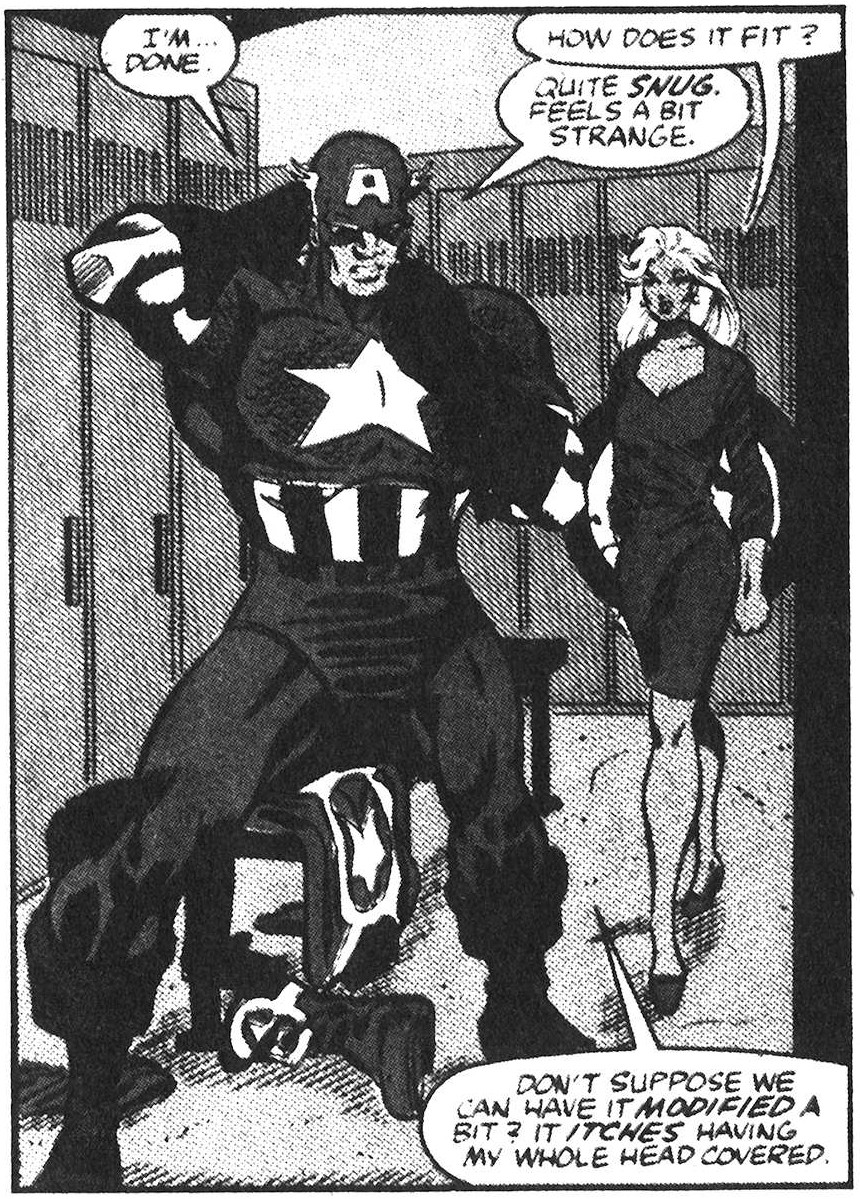
AH: To what do you attribute Captain America’s recent rise in sales?
GRUENWALD: Captain America was on the verge of cancellation a couple of years ago. They had talked about letting it go by the wayside and starting it up again at some point when someone had a great concept. The reason why it got to the point of cancellation was that we cancelled everything that sold less well than it did. So something’s got to be on the bottom.
It was just a shame, since Captain America is Marvel Comics to me. So I said, I’ve got to do something. I think I’m doing good, solid, interesting mainstream material, but if people are just not in the habit of picking up the book, we’ve got to do something to attract their attention. The most immediate thing you can do is get a new art team, and if it’s a hot art team or a soon-to-be-hot art team, that can give sales a boost. [Apart from that] you’ve got to manufacture an Event. And I’d discovered in my ten years of being up here that there are certain sure-fire things you can do to get the book looked at. There are such things as high-concept gimmicks that work; they worked this time. The gimmick will not get them to buy issue after issue. only good stories will do that. But a gimmick will at least get you looked at.
These are the only gimmicks I know of that seem sure-fire and work. Number one, kill somebody important in the book, preferably the lead character [chuckles]. That’ll get the book looked at. Short of that, change the character dramatically. A new uniform might do it. Or get him out of uniform and replace him. Or change his life in some other major way: get him married off or whatever.
So, I did three of the above. Steve Rogers got himself a different uniform. As far as I’m concerned, the original Captain America red, white, and blue uniform is one of the greatest costumes ever invented, and cannot be improved upon any more than Superman’s can. And still we replaced it. The new one’s grown on me. We also replaced the lead character. As of #350, since this storyline started in #332, it’ll be a good eighteen issues so far that Steve Rogers has remained (1) not Cap and (2) in a strange uniform.
Why is the book being read by a fairly significant numbers of new readers? Once they started looking again, they must have liked something they’d seen, because they kept up with it.
I got some of the worst hate mail of my career [laughs]. I got more hate mail than I ever got in my life. How dare you replace Steve Rogers? And what was funny about a lot of this was they would say, “Dear Marvel, I’m not a regular reader of Captain America, but how dare you replace Steve Rogers as Captain America?” And I say if you’re not a regular reader, that’s why we replaced him. Just so you’d be a regular reader. So many of these people admitted that they weren’t regular readers, that they’d lost interest in the character, yet now they were up in arms because we were playing around with the status quo of someone they had lost interest in. That did not hold a lot of water.
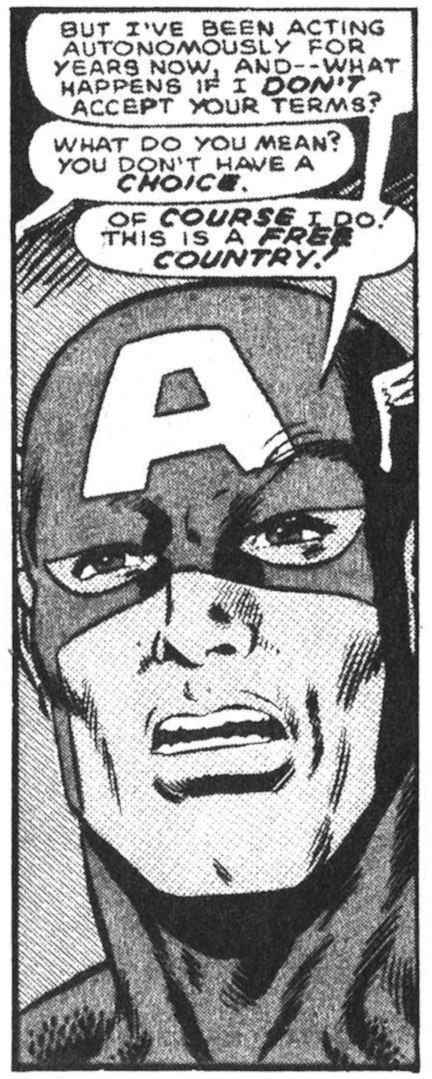
What I predicted would happen and has happened is with each successive month, people were seeing what we were doing, why we were going in the direction that we did, when they discovered that by taking Captain America out of the uniform we could better define what Captain America the concept is. By seeing someone groping, trying to live up to it, trying to grasp all the facets of the concept, we made Steve Rogers look even better by the misfortune that has befallen him. So with each successive issue the fan mail got a little bit better [laughs].
The more surprising thing is that John Walker has actually attracted a following. See, I’ve got other reasons why this storyline came about. The best-selling cover I had [on Captain America] up until this point is the one in which Captain America had a machine gun and was blowing somebody away. That was issue #321 [during the previous Flag-Smasher storyline]. Some of the fans seemed to want me to Rambo-ize Cap, make him tougher, more Punisher-like, more Wolverine-like.
AH: Like Rambo, since, to many people, he’s today’s “national hero” in movies.
GRUENWALD: Yeah. And they’d say, why don’t you just play him this way and he’d be more popular. And I thought that would be a total violation of the character of Steve Rogers as I knew him. So I said, well, if they want Cap as this, I’ll give it to them, but it can’t be Steve Rogers.
And the other thing was that I get this fan letter that was very well-written and thought out asking me a lot of questions about Steve Rogers’s personal life. Among them, he asked if Steve Rogers supports the views of every given political administration. This letter-writer just assumed that Captain America must be a good Republican. Here’s a guy who grew up during FDR’s Democratic administration; why would anyone think he’d be a Republican? I figured, ‘I have to do a storyline that clearly delineates the difference between Cap’s ideas and America’s political reality. We’ve got to show that he is not a tool of the administration, that he transcends the specific political administration, every political administration.’ The only way I could do that, of course, was to have him at odds with it.
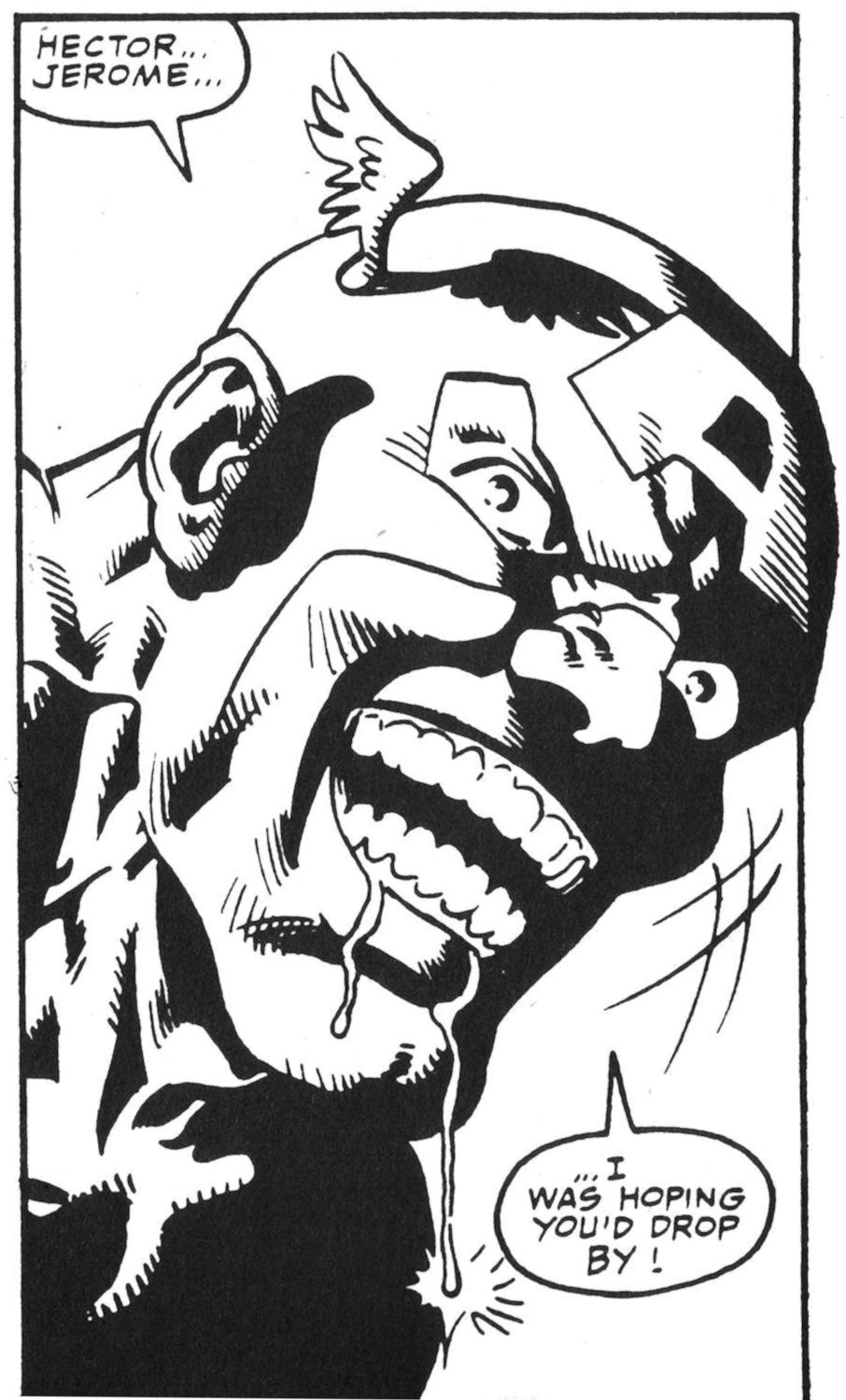
AH: Your storyline is different from the one Steve Englehart did during the Watergate scandal in which Captain America assumed a new costumed identity. In Englehart’s story a member of the administration was corrupt; in yours there are administration members who are not necessarily corrupt but have different goals than Steve Rogers.
GRUENWALD: There seems to be a certain amount of carelessness, not paying attention to details [in the Reagan Administration] so that the Commission on Superhuman Activities is given certain discretionary powers, and, as we learn in issue #348, President Reagan never specifically authorized the removal of Steve Rogers as Captain America and was indeed surprised when they held a press conference announcing he had been replaced. He was not quite advised of that, or, if he was, he lost the memo [chuckles].
AH: Last year a Washington Post reporter asked you if Captain America — Steve Rogers — was an Oliver North-type character since he was acting on his own, outside government authority. Who do you think is more like Oliver North — Steve Rogers, John Walker, or the Commission on Superhuman Activities?
GRUENWALD: I’d say it’s closer to John Walker.
Someone wrote in noticing that many of the characters I’d been doing, mostly villains, had symbolic resonances that had something to do with America today. Flag-Smasher is an anarchist. The Serpent Society represents corporate crime and trade unions. Scourge represents vigilantism, ULTIMATUM terrorism, Mad-cap represented the purposelessness of youth. The Slug was drug-running. The Watchdogs are my idea about censorship and self-appointed moral arbiters. Nomad I turned into a figure of justice untempered by mercy. A lot of people have not liked my handling of Nomad, forgetting that he was the Bucky of the 50s, and this guy was not exactly Mr. Goody Two-Shoes. This was a guy who was beating up on blacks and Communists and he liked it.
I don’t think it’s enough for Captain America, who is a walking symbol, to be hassling with garden-variety super-villains. I think that to do justice to the concept of the character, he’s got to fight [people with some conceptual basis, some symbolic meaning]. The Red Skull was one of his greatest enemies, because he’s got a good look and a good name, he’s got a lot of gimmicks, and he tapped into the Nazi mentality. But I was getting a little tired of Nazism as the only kind of idealistic threat that Captain America would go up against, and it seemed a little bit outdated. I wanted to find all the other forces of oppression that are more prevalent today. I wanted to create characters who could be to these forces of oppression what the Red Skull was to Nazism and totalitarianism. This is not to say that any of the characters I’ve created have approached the Red Skull in terms of excellence as a character, but at least I’m in there trying.
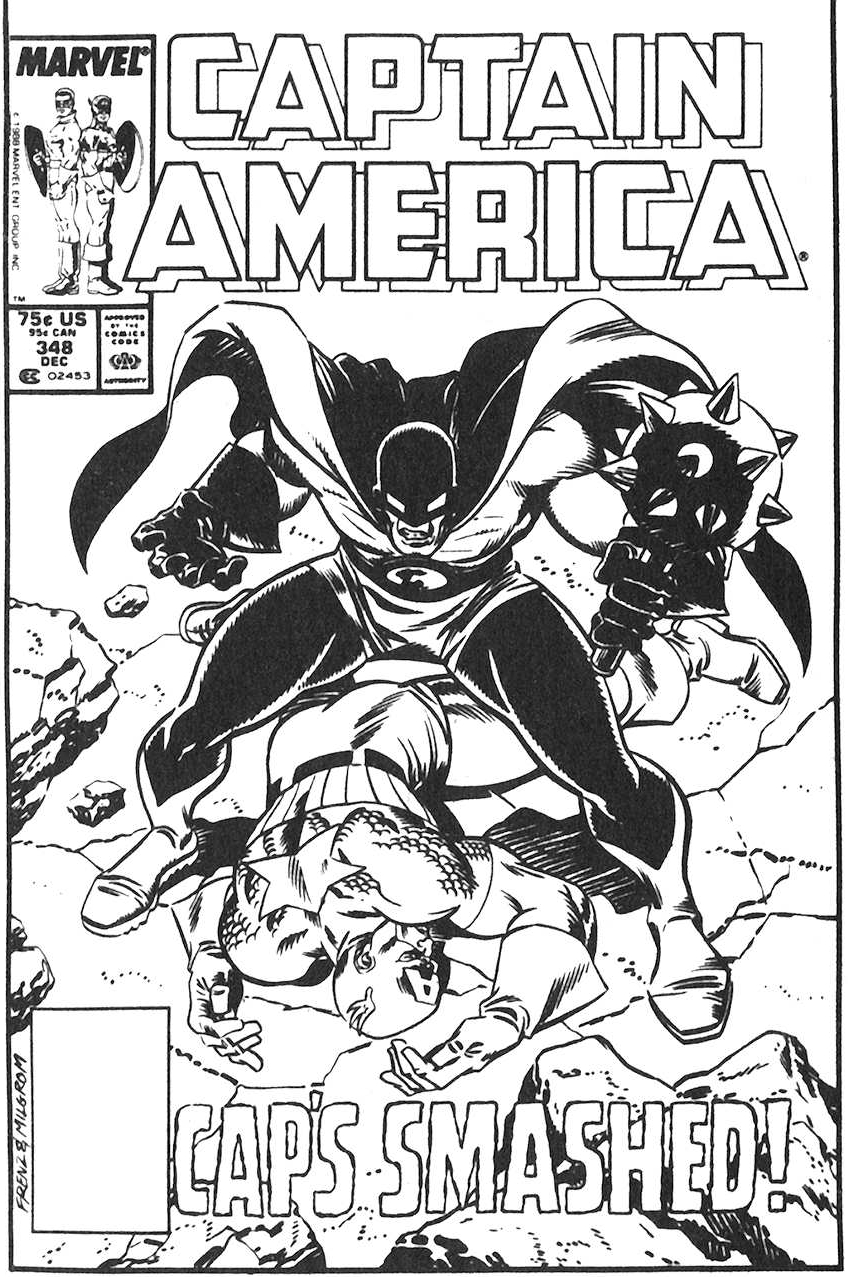
So, I invented the Super-Patriot character [Walker’s original costumed identity] to show that even though Captain America represented patriotism, patriotism was not always a good concept. I was going to show the dark side of patriotism, and thought the way to do that was to have another character who in his own way was just as patriotic as Captain America, but who embodied the dark side of the American dream.
When I invented Super-Patriot, I did not dream he would become Captain America. That was a later idea. So his approach to patriotism is “My country, right or wrong,” and whatever the admistration says is the way it plays, and his interpretation of the American dream is profit-oriented. A lot of people believe the American dream is coming here to America and making a lot of money. That’s not how I see it at all, and it’s certainly not how I see Steve Rogers seeing the American dream. To Steve Rogers, America is a land where you have the opportunity to live up to your potential, to acquire all the things you want out of life provided that you don’t step on other people’s American dreams to do it. For Steve Rogers, money is not a major concern. Instead, it’s having the freedom and opportunity to right the country’s wrongs, to help his fellow man, and to promote the American dream in its true essence.
John Walker is different.
He believes the American dream is to make a mint and then retire. He says, “Yeah, I’m looking after number one. Why is my country so good? Because it’s given me the opportunity to make a lot of money.” That its [the American dream’s] corrupted essence.
That’s why he got into it [being Super-Patriot], because he felt there was room in the marketplace for more than one patriotic figure, and he saw it as a competition between himself and the original Captain America. He thought he was younger and stronger and able to meet the challenge. He was trying to compete in this select market for this franchise of being America’s premiere patriotic hero.
AH: The Commission’s operating independently of Reagan is reminiscent of the Iran-Contra affair.
GRUENWALD: That’s what was so funny. The Washington Post thought the storyline was inspired by the Iran-Contra affair. They knew nothing about comic book lead time. I had all these things I was setting up, like the IRS investigation into Captain America’s back pay, way before the Iran-Contra affair broke.
I guess there are similarities between John Walker’s attitude and Ollie North’s attitude. But the main difference is that John Walker gets things done [laughs]. He’s closer to Rambo than to Ollie North in certain ways. The similarities are there, but I wasn’t inspired by the Iran-Contra affair because I started the storyline before that [became news], and I haven’t really altered the storyline in any way while it’s ongoing. I did have Bernie, Captain America’s ex-girl friend, say “Don’t be sure what the President does or doesn’t know,” when Steve was saying the President must know of his situation.
I got a lot of letters saying, “Captain America’s a fighter. I just can’t believe he would knuckle under to anybody, including the government.” At first, Steve Rogers was not interested in actively opposing members of his government when he figured he bore the whole brunt of their discrimination. If he perceived the Commission as evil, of course he would fight them tooth and nail. But he actually felt that in certain respects they were within their rights to do what they were doing. They were just asking for the reinstatement of the conditions under which he originally was Cap during wartime, for his activities to be coordinated from a central office.
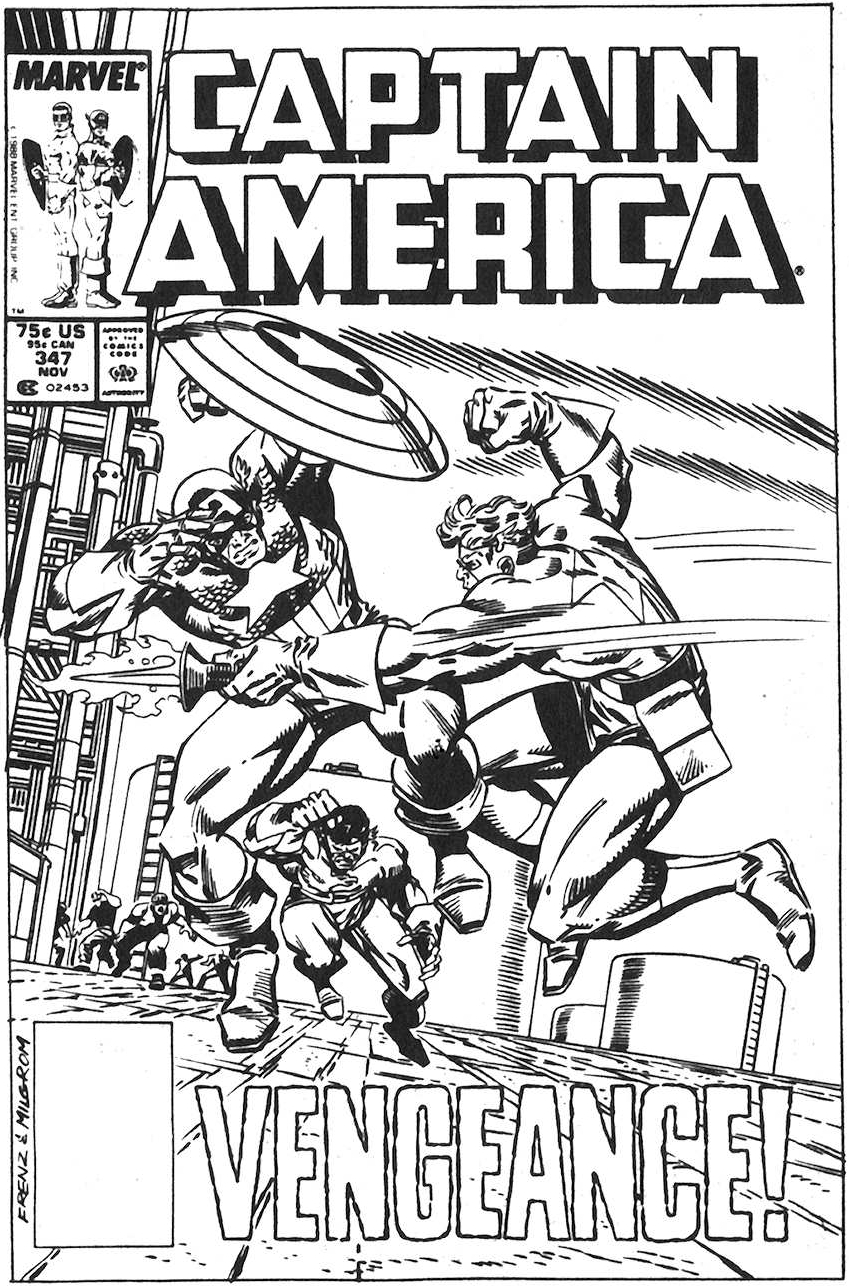
AH: Why has he changed his mind about those conditions?
GRUENWALD: Because he’s been autonomous for years and he’s found that he’s worked better that way. When he’s autonomous, he can decide for himself how to promote the American dream and uphold American ideals, and fight for liberty and justice. During World War II he was a younger guy and it seemed clear where his greatest responsbilities lay.
AH: Back then his adversaries were primarily outside this country whereas now they’re often from within.
GRUENWALD: They’re from within and they’re harder to pinpoint. He wants the discretionary power to decide where it is he should fight against the forces of oppression, tyranny, and crime. Whereas he felt they were within their rights to ask that the original terms of the contract be reinstated, in good conscience he just could not do that anymore. He could not see himself as being something between an ambassador, a mercenary, and a flunky of the government. He felt it was important to keep Captain America independent of political control and to keep the ability for Captain America to represent the entire political spectrum, the entire nation and its people, its dreams and ideals. He felt, if he were doing what one particular administration said, that would compromise his effectiveness as a symbol of all Americans, because he would represent this particular administration.
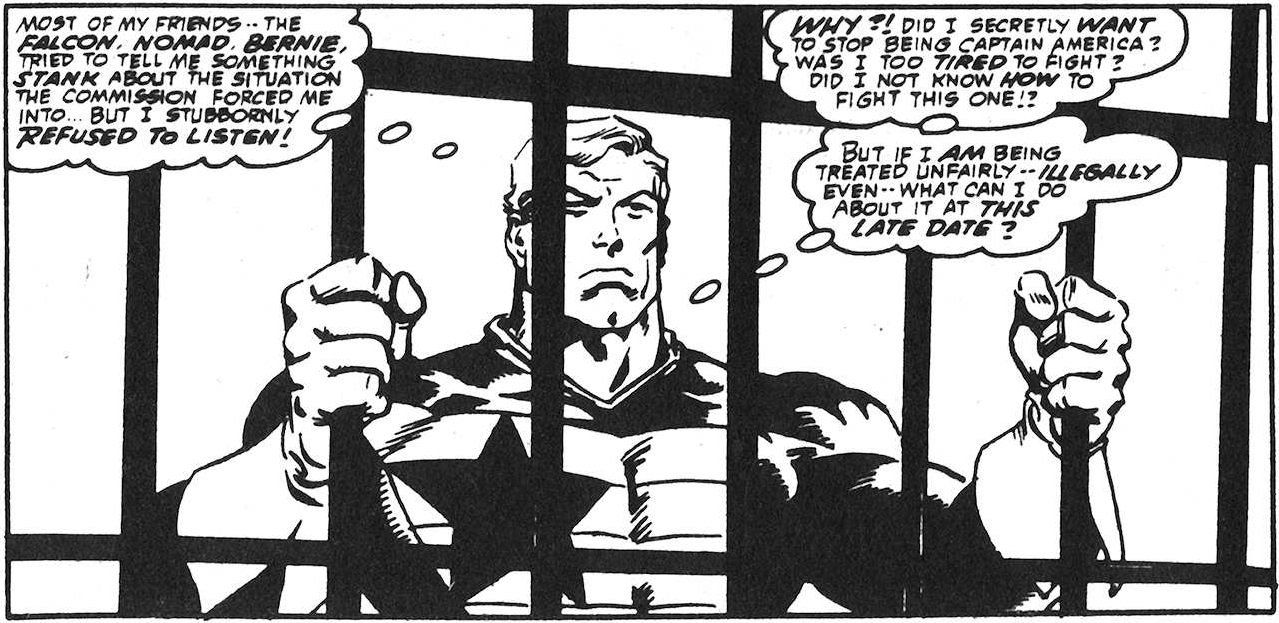
AH: He doesn’t want to be above the law.
GRUENWALD: Not above the law, but he wants to be above the politics. And the best way he can do that is to remain a free agent.
As time has gone by, he’s beginning to realize there must have been other psychological reasons for his deciding not to fight it at that particular time. One of them goes back to his battle with Super-Patriot five issues before [he quit as Captain America]. That battle was the first time an opponent of his stopped a fight when he could have won; Super-Patriot had a chance to see Bruce Springsteen instead. Even the world’s greatest athlete, which is what Captain America is, can have a bad day. The greatest athletes can’t perform to their greatest capacity every single time that they’re up. A fighter can’t win every single fight, or he can’t win every single fight by the same margin. My point is that Captain America, who never loses, can have just the worst day. Maybe he didn’t get quite enough sleep. That day the natural edge he has over everyone else is just a little bit less, because he can’t be perfect all the time. So, it was one of those days, and he happened to fight Super-Patriot that day.
Steve Rogers has harbored some self-doubts from that fight, thinking maybe this one he would have lost if this guy hadn’t gone away to see his pop idol. And I think Steve Rogers now sees this entire series of events, his losing the advantage of being such a well-known hero, as something he’s deliberately done to toughen himself, to purposely give himself some handicaps to overcome in case he was getting at all soft. He sees it as something he’s done to test himself, to see if he has what it takes without having the legend backing him up. One can’t underestimate the power of walking into a place as Captain America. Most people would give up as soon as you walked into the room. If he walks into the room as the Captain, most people will say, “Who’s this guy?” He doesn’t have that legend, so that’s going to make it harder. Psychologically, he wanted that. In his head maybe he had lost this edge, and this is the way to get it back, by giving himself a series of trials.
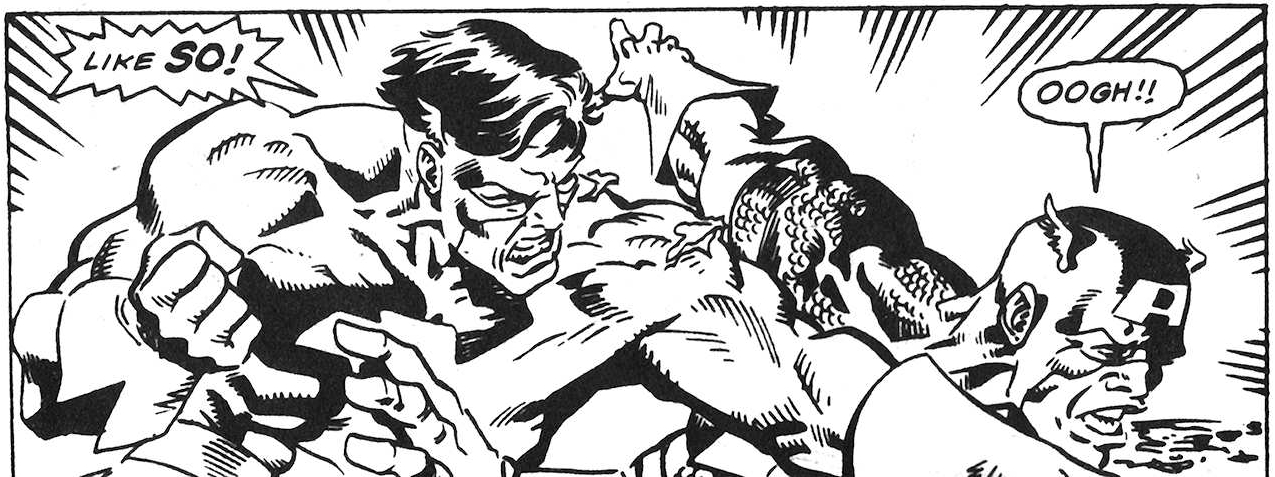
AH: Might he be wrong about the Commission’s motives?
GRUENWALD: He may be wrong about the motives of at least certain Commissioners.
AH: Do you think there are readers out there who might agree with John Walker that Steve Rogers' version of Captain America is a dated concept?
GRUENWALD: Yes. I am now encountering a lot of people who never want Steve Rogers to return. [They see] John Walker, whatever his faults — and he’s got plenty — as more viable, younger, more interesting because you don’t know what he’s going to do. I’ve demonstrated a number of times that he doesn’t have the regard for human life that Steve Rogers has. He killed Professor Power on his very first real mission. He’s taken lives since then. A lot of people say, yeah, this is what they’d rather read in Captain America, about this guy who’s willing to take more drastic measures
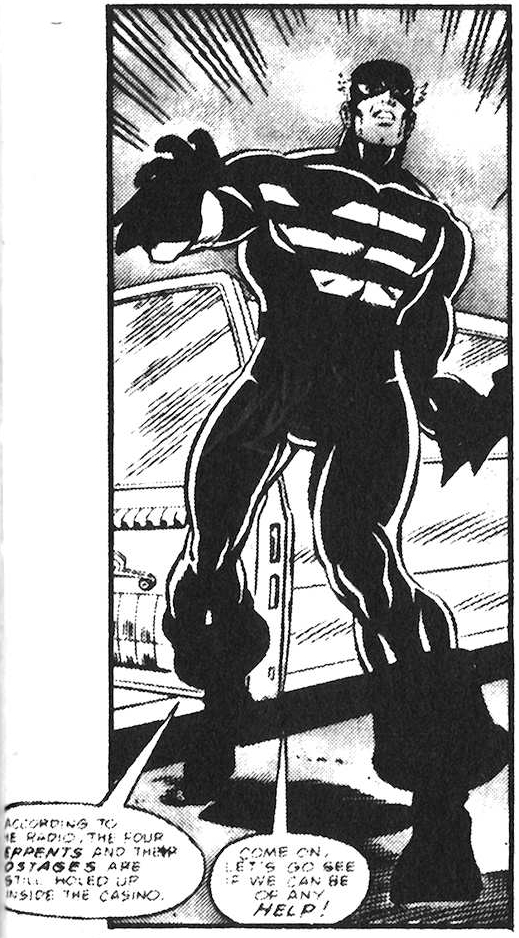
AH: But you don’t agree that Steve Rogers’s ideals are outdated.
GRUENWALD: No.
AH: And this current storyline is to demonstrate that.
GRUENWALD: You took the words right out of my mouth [laughs].
AH: What do you think of the current art on Captain America?
GRUENWALD: It is great. No disrespect to anyone I’ve worked with before, but this is what I’ve always wanted the book to look like. Kieron Dwyer [the penciller]: it’s hard to believe he’s only twenty years old and he’s so good already. He’s improved by leaps and bounds with every issue, and the very first issue he did was no slouch itself. He’s really getting the nuances of all the characters. I think he draws exciting figures and his storytelling is great. He’s going to go far if he stays with the medium.
AH: Do you have other political themes you want to tackle in the future?
GRUENWALD: I’ve got a long list of them, some I haven’t gotten to yet. But I’m not running a political book. It doesn’t have a political point of view. It’s not saying a particular point of view is right. Captain America believes that all political points of view are deserving of free expression; obviously, he doesn’t believe in any that tyrannizes other people. Those are the ones he’s fighting against. The only point of view that’s here is that freedom and justice are good, the Constitution and the Bill of Rights are good.
AH: What do you hope to bring to Marvel in your new role as executive editor?
GRUENWALD: To make sure that we don’t have so many glitches, so many strange things that get by that make me groan because they’re inconsistent, and just a little bit of communication or a little bit of extra work would have been able to make the details jibe into a consistent whole. That’s one thing I’d like to do, to keep things coordinated a little bit better.
AH: You coordinated this year’s “Evolutionary War” storyline in the Marvel annuals.
GRUENWALD: Isn’t it neat to have so many writers approach the same tapestry and weave a little part of it? That’s exciting; that would have been interesting to me when I was a kid. That’s what I’m thinking of trying to do: doing the sorts of things that really would have knocked my socks off as a kid, and made me unable to wait for the next issue, and make me very excited about the state of comics today. I’ve read a lot of comics, so it takes a little more to excite me than when I hadn’t read so many as I’ve read now.
AH: You want to embroider the tapestry of the stories of these characters without reweaving it from the beginning.
GRUENWALD: So far that hasn’t proved necessary and hopefully it never will.
AH: I think you’ve been misinterpreted by many people who thought you were saying Marvel does not revamp characters at all. But then you replace Steve Rogers with John Walker at the same time as the Hulk also goes through so many changes. What you were actually saying, I thought, was that Marvel changes what happens to characters without stating that past stories never happened, the way another company has done of late with many of its characters.
GRUENWALD: I did a “Mark’s Remarks” [column on a letters page] about revamping legends that said for the most part, the 99% part, Marvel does not revamp its legends. It just continues them, and it revamps the status quo from time to time [as I’ve been doing in Captain America]. I define the basic legend as the origin, motivations, and conceptual underpinnings of a character [such as Steve Rogers], his early history. We don’t do major alterations of that. We’re not negating anything. And I don’t think Marvel will have to, because when Stan Lee, Jack Kirby, and Steve Ditko founded the Marvel Universe, one of their premises was to keep things consistent in all the books. With any luck we’ll never have to do wholesale revisions [of past continuinty]. It will not be done while I’m here. [chuckles]
AH: So, even if you won’t tell us who gets to wear the Captain America costume as a result of issue #350, can you at least tell us whether after issue #350 we’ll continue to see both Steve Rogers and John Walker regularly in Captain America?
GRUENWALD: No, not without giving away what’s in #350 [laughs].
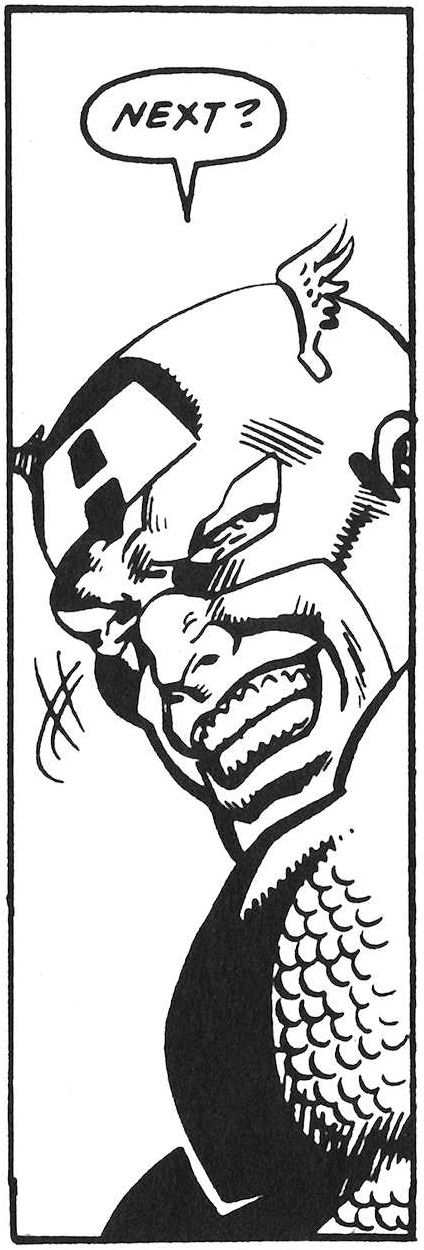
Article © 1988 Fantagraphics Books, Inc. Web Site © 2018-2024 DonValor



